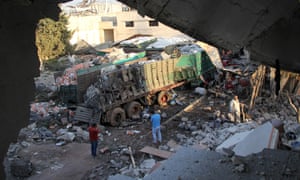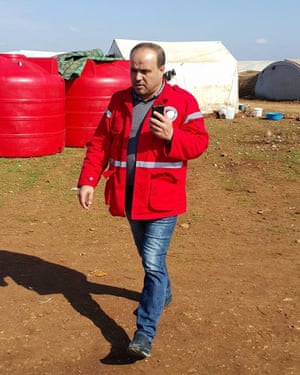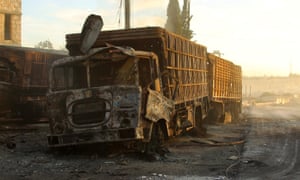The Guardian
Shouting for survivors amid the flaming ruins of lorries, the aid worker was panicking. “It’s September 19 and we have just been attacked by planes,” he yelled as men called frantically for help from the darkness.
The images captured on video in the immediate aftermath of the two-hour bombardment on the aid convoy on the western outskirts of Aleppo reveal the panic of those who survived and their shock at having been targeted on an approved journey to deliver supplies as part of the ceasefire deal brokered byRussia and the US.
Among the dead was Omar Barakat, a father of nine who was the head of the Syrian Arab Red Crescent in the town of Orem al-Kubra, a man directly involved in securing permits for the mission – the first of its kind in the struggling eight-day truce. A total of 20 civilians and aid workers were killed, officials said.
Barakat’s brother Ali told Reuters that more than 20 missiles hit the area, including the one that killed his brother, who was overseeing the unloading of lorries when a bomb hit the warehouse, killing him inside his car.
“The medical team couldn’t make it there for two hours to drag him out because of how intense the bombing was,” said another Red Crescent volunteer who was familiar with the incident. “He was still alive then, but he bled to death on the way to the hospital.”
A rescue worker told Associated Press that missiles pounded the area for hours, even hitting his team as they searched the debris for survivors. Hussein Badawi, who leads the Syrian Civil Defence, also known as the White Helmets, in Orem al-Kubra, said the strikes came from helicopters and land-based missiles.
“There were fires, martyrs, wounded people. We were able to pull out four survivors and five dead bodies at first,” Badawi said. “The bombardment was continuous, continuous. The rescue teams weren’t even able to work. Those who arrived in ambulances couldn’t come in.”
Repercussions from the strike appear to have shattered any hope of the truce enduring and have again highlighted the fraught task of negotiating outcomes in Syria’s raging five-year war. They have also dragged the architects of the deal into another public standoff, withRussia and Syria both denying that their air forces were responsible.
The UN and international aid bodies reacted with fury on Tuesday,suspending all aid deliveries across Syria for three days and raising the possibility that one of the most difficult humanitarian efforts in recent decades could be derailed for longer.
Desperately needed humanitarian relief was to have been a centrepiece of trust-building efforts that had been hailed as the most important peace initiative of the five-year war. But all attempts to deliver it had been stymied in the week since the truce took hold. Monday night’s mission outside Aleppo was meant to change that.
Details of the trip had been meticulously planned in advance, and all the right clearances had been granted by Syrian regime authorities in Damascus and Aleppo. Organising a “cross-line convoy” is no easy feat in the Syrian conflict, with regime officials adamantly opposed to allowing aid into opposition-held areas.
Officials familiar with the process of delivering aid across Syria’s battle lines said requests were first lodged by the UN body OCHA to the Syrian foreign ministry one week ago. Officials had told the Guardian that approval was granted.
The request was then submitted on Monday to the governor of Aleppo and to the security committee in Aleppo, which includes representatives from all the security agencies, the National Defence Front (a pro-regime home guard) and the Ba’ath party. Both the security committee and the governor gave their approval, which allowed the convoy to go ahead.
The application included the names of the organisations involved in the convoy, the planned route and the point at which the convoy would cross the frontline. The amount and type of aid and the point of distribution were also itemised. Before the 31-lorry convoy departed in late afternoon, the number of people travelling with it was also passed on, as were GPS coordinates of the route and destination.
A senior UN official familiar with the steps needed to get previous convoys moving said: “Loading starts in UN warehouses. Normally the Syrian army is watching over us. They monitor what we send. The biggest issue for them has always been surgical and medical supplies. They try to remove them at every chance they get. They don’t want medical supplies getting to the opposition.
“We gave them the coordinates of the convoy. They knew for sure that there was a convoy going to that area.”
The UN said 18 of the lorries were damaged or destroyed and insisted on Tuesday that the damage to them had been caused by airstrikes. Bystanders at the scene of the attacks reported multiple airstrikes.
US officials said they believed that Russian aircraft had carried out the attack, but the White House did not confirm the allegations, saying Russia was ultimately responsible, whichever planes carried out the attack.
Robert Ford, a former US ambassador to Syria, who is now a fellow at the Middle East Institute in Washington, said: “Boxing the Russians in publicly would likely bring the ceasefire to a crashing halt. If they go privately, if Kerry says to Lavrov, ‘Hey, this is what we have,’ then the Russians can decide to cooperate.”
Russia attempted to shift blame to rebel groups in the area, suggesting that the damage to the lorries did not appear to have been caused by explosions and may have been the result of fire.
“They do this all the time,” said a senior official from the Free Syrian Army’s 101st division. “They lie like they breathe. It could only have been them or the regime, and the strikes were more accurate than Assad’s air force.”
Members of the Syrian Red Crescent, who had travelled from regime-held west Aleppo to make the delivery were too scared to share what they had seen, fearing punishment from Syrian officials.
“They want to kill humanity, but humanity will not die,” said one of Barakat’s colleagues, insisting his name was not used.




No comments:
Post a Comment